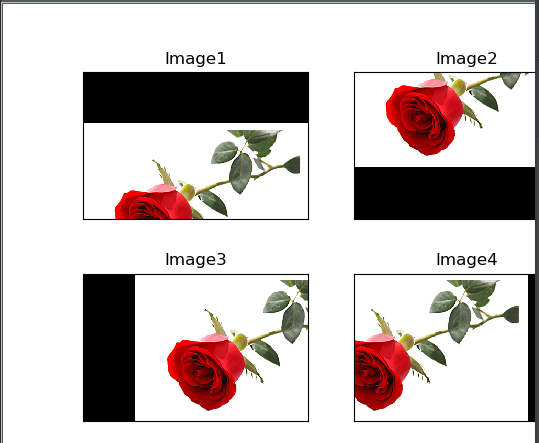图像缩放
图像缩放主要是调用resize()函数实现,result = cv2.resize(src, dsize[, result[.fx, fy[,interpolation]]]) 其中src表示原始图像,dsize表示缩放大小, fx,fy也可以表示缩放大小倍数,他们两个设置一个即可实现图像缩放。
eg: result = cv2.resize(src, (160, 60)) | result = cv2.resize(src, None, fx=0.5, fy=0.5)
代码如下:
import cv2 def test16(): src = cv2.imread("rose.jpg") # 图像缩放,设置的dsize是列数为200, 行数为100 result = cv2.resize(src, (200, 100)) print(result.shape) # (100, 200, 3) cv2.imshow("demo1", src) cv2.imshow("demo2", result) if cv2.waitKey(0) == 27: cv2.destroyWindow("demo1") cv2.destroyWindow("demo2") test16()
效果如下:

也可以获取原始图像像素再乘以缩放系数进行图像转换
代码如下:
import cv2 def test17(): src = cv2.imread("rose.jpg") rows, cols = src.shape[:2] # 图像缩放dsize(列,行) result = cv2.resize(src, (int(cols*0.6), int(rows*0.4))) cv2.imshow("src", src) cv2.imshow("result", result) cv2.waitKey(0) cv2.destroyAllWindows() test17()
效果如下:

(fx,fy)缩放倍数的方法对图像进行放大或缩小
代码如下:
import cv2 def test18(): src = cv2.imread("rose.jpg") # 图像缩放 result = cv2.resize(src, None, fx=0.3, fy=0.3) cv2.imshow("src", src) cv2.imshow("result", result) cv2.waitKey(0) cv2.destroyAllWindows() test18()
效果如下:

图像旋转
图像旋转主要调用getRotationMatrix2D()函数和warpAffine()函数实现,绕图像的中心旋转,具体如下:
M = cv2.getRotationMatrix2D((cols/2, rows/2), 30, 1)
参数分别为:旋转中心、旋转度数、scale
rotated = cv2.warpAffine(src, M, (cols, rows))
参数分别为:原始图像、旋转参数、原始图像宽高
代码如下:
import cv2 def test19(): src= cv2.imread("rose.jpg") rows, cols, channel = src.shape # 绕中心旋转 # 参数:旋转中心,旋转度数,scale M = cv2.getRotationMatrix2D((cols/2, rows/2), 30, 1) # 参数: 原始图像,旋转参数, 元素图像高度 rotated = cv2.warpAffine(src, M, (cols, rows)) # 显示旋转后的图像 cv2.imshow("demo1", rotated) cv2.waitKey(0) cv2.destroyAllWindows() test19()
效果如下:

备注: 参数中的旋转度数设置为正数时表示逆时针旋转,为负数时表示顺时针旋转
图像翻转
图像翻转在OpenCV中调用函数flip()实现,原型如下:
dst = cv2.flip(src, flipCode)
其中src表示原始图像,flipCode表示翻转方向,如果flipCode为0,则以X轴为对称轴翻转,如果fliipCode>0则以Y轴为对称轴翻转,如果flipCode<0则在X轴、Y轴方向同时翻转。
代码如下:
import cv2 import matplotlib.pyplot as plt def test20(): # 读取图片 img = cv2.imread('rose.jpg') src = cv2.cvtColor(img, cv2.COLOR_BGR2RGB) # 图像翻转 # 0以X轴为对称轴翻转 >0以Y轴为对称轴翻转 <0 X轴Y轴翻转 img1 = cv2.flip(src, 0) img2 = cv2.flip(src, 1) img3 = cv2.flip(src, -1) # 显示图形 titles = ['Source', 'Image1', 'Image2', 'Image3'] images = [src, img1, img2, img3] for i in range(4): plt.subplot(2, 2, i + 1), plt.imshow(images[i], 'gray') plt.title(titles[i]) plt.xticks([]), plt.yticks([]) plt.show()
效果如下:

图像平移
图像平移首先定义平移矩阵M,再调用warpAffine()函数实现平移,核心函数如下:
M = np.float32([[1, 0, x], [0, 1, y]]) 其中(x,y)即为要偏移的x值,y值
shifted = cv2.warpAffine(image, M, (image.shape[1], image.shape[0]))
代码如下:
import cv2 import numpy as np import matplotlib.pyplot as plt def test21(): # 读取图片 img = cv2.imread('rose.jpg') image = cv2.cvtColor(img, cv2.COLOR_BGR2RGB) # 图像平移 下、上、右、左平移 M = np.float32([[1, 0, 0], [0, 1, 100]]) img1 = cv2.warpAffine(image, M, (image.shape[1], image.shape[0])) M = np.float32([[1, 0, 0], [0, 1, -100]]) img2 = cv2.warpAffine(image, M, (image.shape[1], image.shape[0])) M = np.float32([[1, 0, 100], [0, 1, 0]]) img3 = cv2.warpAffine(image, M, (image.shape[1], image.shape[0])) M = np.float32([[1, 0, -100], [0, 1, 0]]) img4 = cv2.warpAffine(image, M, (image.shape[1], image.shape[0])) # 显示图形 titles = ['Image1', 'Image2', 'Image3', 'Image4'] images = [img1, img2, img3, img4] for i in range(4): plt.subplot(2, 2, i + 1), plt.imshow(images[i], 'gray') plt.title(titles[i]) plt.xticks([]), plt.yticks([]) plt.show() test21()
效果如下:

转自:https://blog.csdn.net/Eastmount/article/details/82454335